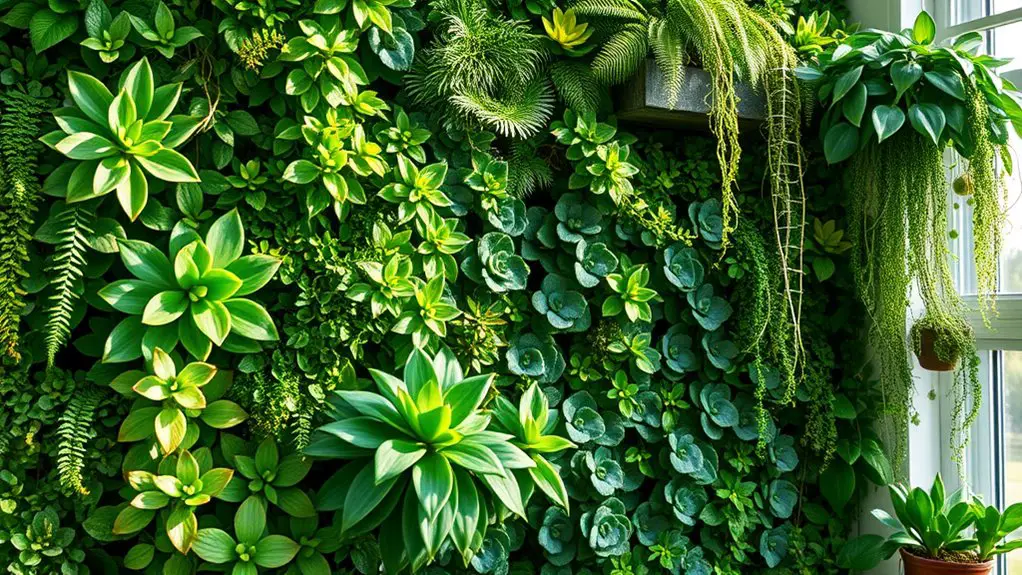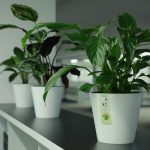Creating a plant wall can greatly boost your indoor air quality and mood. Start by selecting the right type of plant wall, like living or hydroponic. Choose suitable plants such as Pothos or Peace Lily for air purification, and arrange them based on your space. Make sure to integrate lighting for ideal growth. Regular maintenance is key to keeping your plants healthy. Keep exploring to discover more tips and tricks for your perfect plant wall.
Table of Contents
Key Takeaways
- Choose air-purifying plants like Pothos and Peace Lily to enhance indoor air quality and mood.
- Design the layout by mixing different plant textures and colors for visual interest and emotional impact.
- Optimize light exposure with plants that thrive in your space, ensuring they receive 6-8 hours of sunlight daily.
- Implement a regular watering and maintenance schedule to keep plants healthy and vibrant.
- Consider using hydroponic systems for innovative, low-maintenance plant walls that still improve air quality.
Understanding the Benefits of Plant Walls
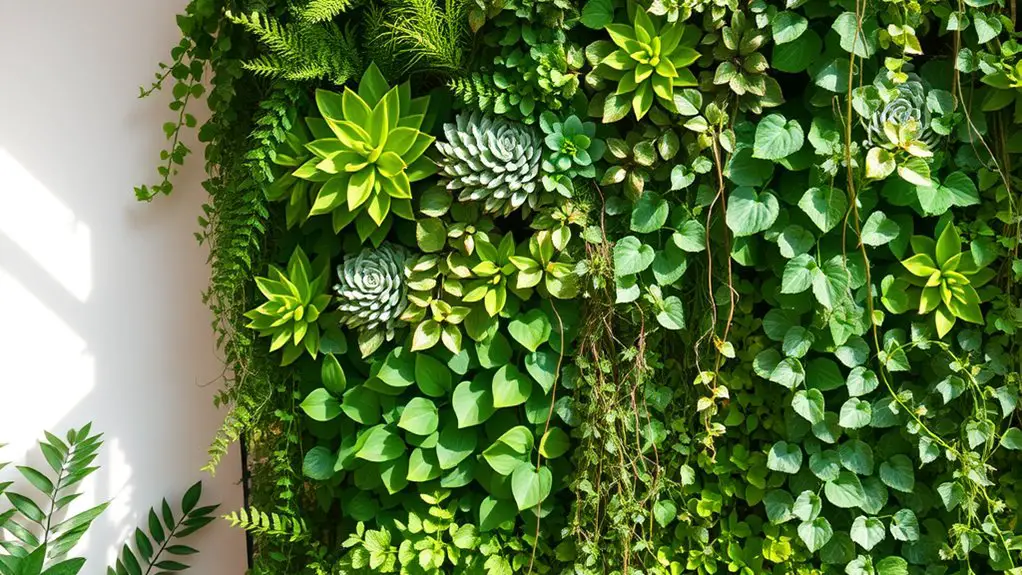
When you consider creating a plant wall, you'll quickly realize the myriad benefits it offers, from improving air quality to enhancing your living space's aesthetics.
These green walls act as natural air filters, removing pollutants and absorbing carbon dioxide, which helps reduce greenhouse gas emissions. They trap harmful toxins like formaldehyde, greatly improving indoor air quality. Plus, the foliage can capture particulate matter, lowering urban pollution levels. Green walls also produce oxygen, enhancing overall air quality. Additionally, the selection of appropriate plant species is crucial for maximizing their air pollution reduction effectiveness.
Green walls naturally filter air, remove toxins, and produce oxygen, significantly enhancing indoor air quality and reducing pollution.
Beyond air purification, they support local wildlife, reduce noise, and help manage stormwater runoff.
Ultimately, incorporating a plant wall creates a healthier environment, elevates your mood, and beautifies your space, making it a beneficial addition to any home or office.
Choosing the Right Type of Plant Wall
Choosing the right type of plant wall can greatly impact both your space and your experience with greenery.
You can opt for a moss wall, which requires minimal maintenance and thrives in low-light areas, making it an ideal choice for beginners. Moss Walls require no watering or sunlight, which adds to their convenience.
If you're looking for air quality benefits, consider living walls with a variety of plants, but be prepared for regular care.
Geoponic walls use traditional soil-based methods while hydroponic walls offer innovative, soil-free growing systems.
For flexibility, semi-intensive green walls combine climber plants with planters, letting you customize your design.
Each type has different installation costs and maintenance needs, so evaluate your preferences and environment before making a decision.
Selecting Suitable Plants for Your Wall
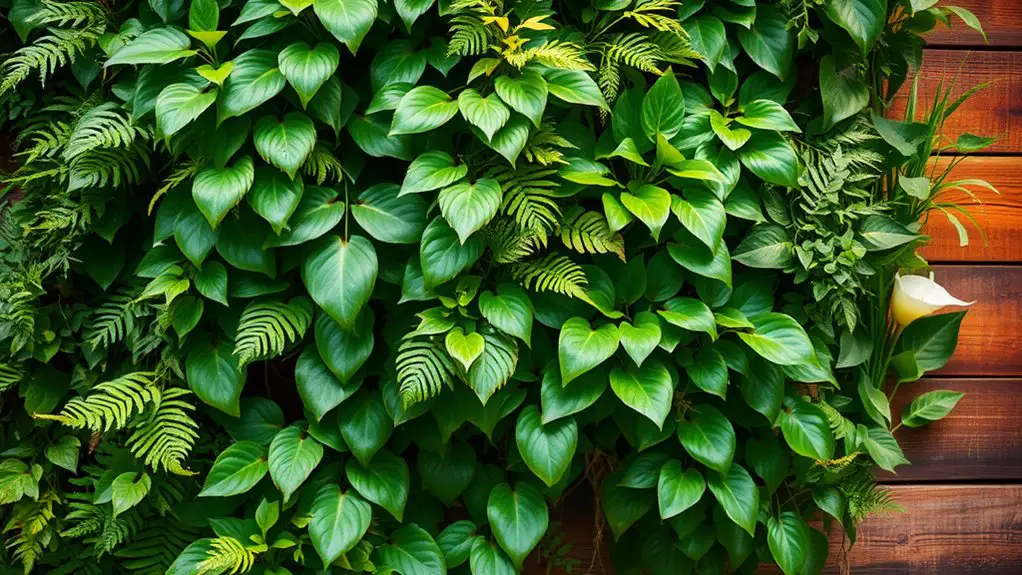
How can you guarantee your plant wall thrives and looks stunning? Start by selecting the right plants based on their needs and your environment. Consider air-purifying plants like Pothos and Peace Lily, or opt for low-maintenance succulents and cacti. If you have a humid space, ferns like Boston Fern can flourish beautifully. Indoor green walls can elegantly decorate your space while also providing numerous environmental benefits. Here's a quick guide to help you choose:
| Plant Type | Examples |
|---|---|
| Air Purifying | Pothos, Peace Lily |
| Moisture Loving | Boston Fern, Maidenhair Fern |
| Low Maintenance | Succulents, Cacti |
| Climbing Plants | Philodendron, Ivy |
| Flowering Plants | Anthurium, Phalaenopsis |
Choosing the right plants guarantees a healthy, eye-catching wall that enhances your space.
Designing Your Plant Wall Layout
Designing your plant wall layout is essential for creating a stunning focal point in your space. Start by optimizing your wall area with compact planters or shelves, especially in smaller rooms. Consider the lighting conditions; most plants thrive with 6-8 hours of natural sunlight. Use your plant wall to define spaces or create backdrops, enhancing your interior's functionality. For visual interest, mix different textures, colors, and leaf sizes. You can choose geometric patterns for a modern look or linear layouts with trailing plants like pothos. Incorporate low-maintenance options like preserved moss or air plants for ease. Finally, consider the wall type and materials, such as pocket planters or floating shelves, to achieve your desired aesthetic. Additionally, selecting plants with similar watering needs is crucial for maintaining a healthy and vibrant plant wall.
Installation Process for Plant Walls
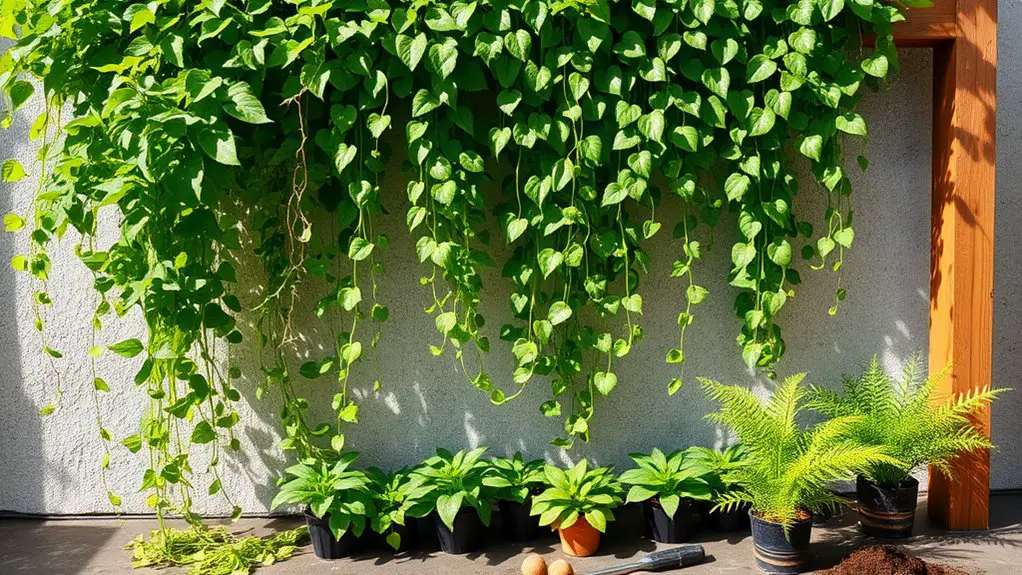
Before diving into the installation process for your plant wall, it's crucial to prepare adequately to guarantee a successful setup. Start by selecting a location with the right light and confirming the wall can support the weight. Waterproof the area to prevent moisture damage, and gather your tools and materials. Proper irrigation systems are also essential to ensure your plants thrive.
Here's a quick overview of installation steps:
| Step | Action | Purpose |
|---|---|---|
| Location Selection | Choose ideal light conditions | Supports plant health |
| Wall Support | Check weight-bearing capacity | Confirms stability |
| Mounting Support | Securely attach support structure | Provides structure for the system |
| Planting Process | Insert plants and water thoroughly | Promotes growth |
Consider professional help for complex installations, and you'll be well on your way to a thriving plant wall!
Maintenance Tips for Healthy Plant Walls
To keep your plant wall thriving, stick to a regular watering schedule that meets your plants' needs. Regular maintenance is essential to ensure plant health and longevity, so don't skip these tasks. Pruning and trimming are also essential to maintain their shape and health, so don't skip these tasks. With consistent care, your plant wall will flourish beautifully. Remember to schedule monthly maintenance to keep an eye on your plants' health and prevent issues.
Regular Watering Schedule
Maintaining a regular watering schedule is essential for keeping your plant wall healthy and thriving, especially since different plants have varying moisture needs.
Here are a few tips to help you establish an effective routine:
- Automate When Possible: Use a drip irrigation system with timers, adjusting settings based on your plants' light exposure and climate. Implementing a recirculating living wall system can further enhance water conservation and plant health.
- Monitor and Adjust: Regularly check soil moisture and plant health, making adjustments as necessary to prevent overwatering or underwatering.
- Ensure Water Quality: Keep your water source clean and replace recirculating water every few months to avoid buildup.
Pruning and Trimming
A regular watering schedule sets the foundation for a thriving plant wall, but keeping it healthy also requires proper pruning and trimming.
Start by using sharp tools, like shears or loppers, to make clean cuts just above growth nodes. This encourages new growth and maintains appearance. Prune lightly on narrowleaf evergreens to avoid dead zones, while broadleaf evergreens can handle more aggressive cuts. Thinning should involve removing branches back to a lateral bud to promote better air circulation and overall health.
For vining plants, regular trimming promotes fuller growth. Always sterilize your tools between cuts to prevent disease spread. Prune during the dormant season or right before new growth to minimize stress.
Regularly check for pests or diseases, and don't hesitate to hire a professional for larger tasks. Maintain a pruning schedule to keep your plant wall vibrant and healthy.
Enhancing Indoor Air Quality and Mood With Plant Walls
While indoor environments often suffer from poor air quality, incorporating plant walls can considerably enhance both the atmosphere and your mood. By integrating these living structures, you benefit from cleaner air and a serene environment.
Incorporating plant walls transforms indoor spaces, improving air quality and elevating your mood for a healthier, serene environment.
Here are some key advantages:
- Air Quality Improvement: Plants absorb harmful pollutants and release oxygen, promoting fresher air. Indoor plant walls significantly reduce harmful substances, further improving air quality.
- Humidity Regulation: They release moisture, helping maintain ideal humidity levels for comfort.
- Mood Enhancement: The greenery creates a calming effect, reducing stress and boosting productivity.
With a plant wall, you not only beautify your space but also embrace a healthier lifestyle, making it a win-win for both your air quality and overall well-being.
Frequently Asked Questions
How Much Sunlight Do Plant Walls Require?
Plant walls generally need varying sunlight depending on the plants chosen. Some thrive in low light, while others require partial sun. Using grow lights can help meet their needs, especially during darker months.
Can I Install a Plant Wall Outdoors?
Yes, you can install a plant wall outdoors. Just guarantee you choose weather-resistant materials, provide proper drainage, and select plants suited for your climate to thrive and create a beautiful green space.
What Are the Costs Associated With Plant Walls?
When considering plant walls, you'll face initial costs ranging from $80 to $300 per square foot, depending on type and installation. Maintenance, plant selection, and irrigation systems can also greatly affect your overall expenses.
Do Plant Walls Attract Pests or Insects?
Yes, plant walls can attract pests and insects. However, by choosing diverse, pest-resistant plants and maintaining proper care, you can encourage beneficial insects while minimizing pest problems, creating a healthier environment overall.
How Long Do Plant Walls Typically Last?
Plant walls typically last several years, depending on plant selection, environmental conditions, and maintenance. By choosing resilient plants and ensuring regular care, you can greatly extend their lifespan and enjoy their benefits longer.
